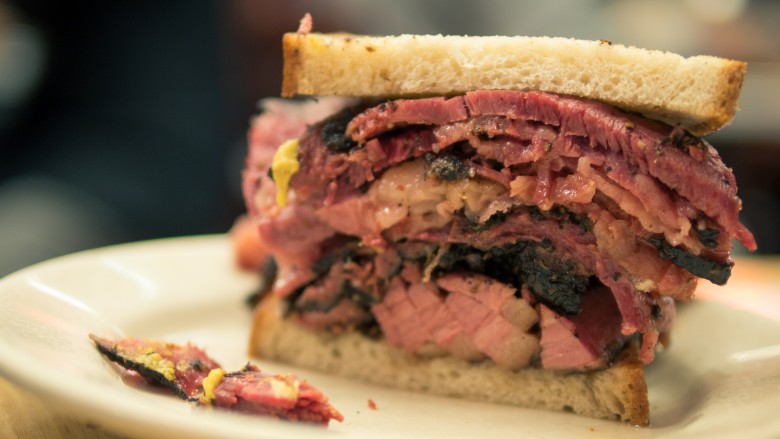Prisons That Became Non-Stop Party Venues
Jailhouse Rock may have told us that prison is like a musical, but it's actually more of a Heartbreak Hotel, one with lots of stabbing — not always, though. The convicts featured in this article, for example, turned penitentiaries into oversized playgrounds, proving that the fun you have in prison can be the time of your life sentence.
The Roman birthday bash
When you hear the words "Russian jail," you probably imagine a place where the human spirit goes to drink itself to death. But in the town of Serpukhov, a group of jovial jailbirds thought otherwise. In 2011 inmates of Serpukhov's Prison Number Three threw a toga party for felonious Caesar and special birthday boy Anton Kuznetsov. The men dressed as Roman senators, gladiators, and a lion. They even carried cardboard swords and tridents, in lieu of their usual shivs.
Using contraband cellphones, the inmates documented their costumed playdate. They photographed themselves enjoying an array of fruits, salads, and booze. Kuznetsov, of course, made out like a bandit, feasting on red caviar, bread, and what looked like a bag of McDonald's takeout (which is sort of like food).
When images of the fast food and fancy feast went public, the media had a field day. Russia's top prison officials were livid — the country's penal system already had a reputation for corruption and mismanagement, and photos of convicts acting like half-naked frat boys didn't help. To make matters worse, these shenanigans reflected a much larger problem at Prison Number Three, which treated big-time crooks like bestest buddies. Unsurprisingly, federal officials responded by firing the facility's staff. Sadly, they also missed a rare opportunity to make the crooked jailors fight in a prison coliseum. Seriously, the costumes were right there.
The holiday melee
Haymakers make terrible Christmas gifts. They're impossible to wrap, and often leave black-and-blue stains all over your body. Nonetheless, in 2016 the raucous residents of HMP Hindley, a prison in the UK town of Wigan, dreamed of a bare-knuckle Christmas. Despite obviously being on Santa's Naughty List, the men got their wish.
Forget roasting chestnuts over an open fire. HMP Hindley's convicts lit each other up with the Yuletide magic of ungloved fisticuffs, like if Santa got fired and replaced with Tyler Durden. Cellphone footage taken by one of the prisoners featured inmates trading blows as a makeshift referee excitedly egged them on in indecipherable British-ese. When the men weren't obliterating each other's brain cells with punches, they doused their neurons in alcohol, smoked a suspiciously marijuana-like substance, and danced. As one of the chaotic revelers proclaimed, "This is how we do Christmas in Hindley boys!"
Prison officials wagged their fingers disapprovingly, but were in no position to criticize. Holiday slugfest aside, Hindley was a human rights nightmare. Inmates regularly endured 24-plus-hour stints in their cells and often lacked clothes, showers, and bedsheets. Just weeks before Christmas, a prison inspector reported that the facility was so plagued by violence, mold, and overcrowding, that many detainees resorted to drugs or attempted suicide. In short, Hindley had become diet-Attica. Authorities should have been grateful the inmates spent Christmas boxing, rather than rioting.
The Facebook felons
You know your country's prison system has jumped a Jaws-sized shark when one of its penitentiaries has an inmate-run Facebook page dedicated to degeneracy. Marseilles, France's Baumettes Prison crossed that threshold twice, with a page impertinently titled MDR o Baumettes ("LOL in the Baumettes"). Its various posts featured gleeful detainees waving wads of cash, doing dope, and flashing their manly pecs with topless abandon. Amazingly, the page amassed 5,000 likes, likely from people who confused it with scenes from a rap video.
Staff first noticed the social media activity in January 2015. Vexed by the convicts' bare-chested impudence, they unleashed an impassioned "sacré bleu!" and closed the offending account. Undeterred, the merry troublemakers at Baumettes counter-punched with a second Facebook page, this time making sure to mask prisoners' identities with, well, masks. MDR o Baumettes had become an obstinate fist in the face of power, and the "MDR" now clearly stood for "Middle Digit Raised." It also emblemized the detention center's abysmal state.
Once described as being on the "borderline of human dignity," Baumette housed 50% more inmates than it had room for, and suffered from severe understaffing. Worsening matters, a 2009 law placed strict limits on contraband searches, making it way easier for prisoners to stockpile knives, narcotics, and Facebook fans. On multiple occasions, frustrated guards voiced their frustrations the only way Frenchmen know how: by protesting. Sadly, the idea of sympathizing with French jailors was too revolutionary for the public to handle.
The dirty dance
Speaking of rebellion, children have a real knack for it. Occasionally their unruliness goes too far, however, and they murder people. When that happens, the rambunctious little scamps get sent to places like Orange County, New York's Goshen Secure Center, for a special timeout. Devoted to housing juvenile boys, Goshen has a staff of grown-ups who try to promote youthful innocence through fun activities. Sometimes that fails miserably, like the time Goshen threw a dance party that devolved into a sex fest.
Held in December, 2009, the juvenile detention center's "Winter Social Dance" was supposed to reward four inmates for good behavior. All four had a documented history of behavioral problems, and the contradictions only get richer from there. In the name of encouraging wholesome fun, the staff let each honoree invite a female plus-one. So naturally, the guest list consisted of sexually precocious teenagers, and at least one prostitute. Without screening any of these invitees, staff drove all the way to Albany and New York City to pick them up.
Predictably, sex and lap dances ensued. Goshen officials, clearly stunned by the prurience of adolescent males, stood by and did nothing. In the aftermath, employees refused to take responsibility like adults. They not only failed to properly report the incident, but a supervisor also doctored forms to hide his blunders. True to form, they botched the cover-up as well, getting caught and soundly scolded. We can only hope that Goshen's young inmates didn't learn by example.
The dirty dancers
Strippers and defense attorneys have a lot in common. Both get paid to perform for an audience. Both attract some of society's shadiest characters. And both have a reputation for abject sleaze. Then again, there are also huge differences. Strippers, for instance, tend to be much better dressers than lawyers. And unlike defense, they're barred from wearing their fancy work clothes inside of a prison. There is a glaring exception to that rule, however: Miami, Florida's Federal Detention Center (FDC).
According to defense lawyers interviewed by the Miami New Times in 2011, drug kingpins at the FDC found a way to smuggle South American strippers into the maximum-security compound. How? Well, since most human butts can't accommodate a whole person, the dons exploited a massive loophole instead. You see, the FDC had a visitor protocol that consisted of signing people in and ... that's basically it. Drug lords simply had the dancers pose as paralegals. And because prisoners did all the strip-searching in this scenario, they had no problem getting the women to sneak cash, alcohol, and other coveted no-no's into the building.
Dismayed attorneys charged that prison officials knew about the ruse, and did absolutely squat. A cocktail of weak regulations and even weaker enforcement seemingly rendered the FDC's staff impotent against naked corruption. Lawyers could only gawk as their clients enjoyed hands-on anatomy lessons from professional nudists. In most cases, they acquiesced to avoid getting fired, although one outspoken attorney openly welcomed the prison peep shows. We bet the guards did, too.
The even DIRTIER dancers
Florida's famous for two things: succulent oranges and jailhouse strippers ... okay, maybe that second thing isn't so well known yet. But at the rate they're going, it soon will be.
In keeping with the state's bid to have "naked" replace orange as the old black, let's pay a visit to Pasco County's Sumter Correctional Institute, where hardened criminals got wild with exotic dancers. Unlike the clever dons at Miami's FDC, however, these guys skipped the guile and just plain bribed a guard.
The scandal came to light in September 2014, when police apprehended escaped inmate Jason Adams as he jollily rode a bicycle toward freedom. While under interrogation, Adams admitted that he had escaped once before but voluntarily returned, prompting violent bouts of head-scratching and disbelief. Upon further investigation, and a survey of the prison grounds, the reason became abundantly clear: Sumter didn't just put a roof over Adams' head, it also provided him sex, drugs, money, sex, and sex (also sex).
As it turned out, a prison work crew had a special arrangement with corrections officer Henry Blackwelder. If they plied him with money and food, he would let them spend their assigned work period getting drunk, high, and frisky with two strippers who helped smuggle paraphernalia. The men even had a special lovemaking blanket where they made not-war. Unfortunately for Blackwelder, all that not-warring he facilitated trapped him in a losing battle against unemployment and arrest. If he's lucky, he'll end up on a Sumter work crew.
The kosher kingpin
New York City's Manhattan Detention Complex is unflatteringly nicknamed "The Tombs," which is kind of weird, since no dead people live there. What makes it even weirder is that, in addition to being corpse-free, The Tombs has served as the location for some pretty lively gatherings. One of those slammer shindigs was a bar mitzvah.
The bar mitzvah took place in 2008 at the behest of jailed financial fraudster Tuvia Stern. Held in the jail's gym, the 60-guest ceremony featured live music, kosher food, and metal eating utensils (known commonly among inmates as "weapons"). Despite the unorthodox setting and unfettered access to knives, the event went rather stab-lessly. Pleased, Stern later used The Tombs to host an engagement party for his daughter, who no doubt prayed he'd be released early enough to avoid a jailhouse wedding.
You're probably wondering how Stern turned The Tombs into a series of precious Hallmark moments. Well, for years, jailhouse rabbi Leib Glanz exploited ties to God and government to land illicit perks for Jewish detainees. Whether a bar needed mitzvah-ing, or someone just really wanted a pastrami sandwich, Jews knew they could count on the rabbi (he drew the line at BLT's, however). So it must have come as a huge disappointment when Rabbi Glanz got canned for misconduct, and later got sent to the can for rent fraud. After all, why go to jail if you can't have your own personal pastrami guy?
The other Sin City
Everyone recognizes Nevada as "the word which comes after Las Vegas." But there's a lot more to the Silver State than licentious gambling. For example, did you know that for 35 years, Carson City's Nevada State Prison ran an unlicensed casino where prisoners indulged in craps, rummy, blackjack, and sports betting?
Operated between 1932 and 1967, the casino served as a way to keep condemned killers and bruisers from condemned-killing and bruising people. Corrections officials figured that any den of outlaws worth their salt would have fun by hook or by crook (we'll let you guess which), so letting them build a casino seemed like the safest bet. All the action took place in a stone structure called the "Bullpen," where cheaters could look forward to getting gored. No, seriously. According to former inmate Carl Osborne, rule breakers "might have to be transferred out of state for their own safety."
Potential homicides aside, the joint was run pretty professionally. It had a system of betting tokens, and veteran gamblers ran the tables. Both inmates and invited guests could join, meaning that hardened criminals ended up playing alongside wardens, guards, and state agency heads. It was downright harmonious — gaming archaeologist Howard Herz even implicated the Bullpen as America's first racially integrated casino. The utopian sinfulness didn't last, sadly. After a 1967 riot, the presiding warden nixed the casino. He then instituted more family-friendly pastimes like bridge and shuffleboard, effectively making Nevada State the state's roughest nursing home.
The murderers' mansion
Prison should never be the place where you get your big break in life (especially if that break has the word "jail" in front of it). This seems especially true of the Philippines, which has a record of inmate abuse that falls somewhere between "movie villain and "Vlad the Impaler" on the depravity scale. But at Bilibid Prison, located just outside Manila, champagne wishes and caviar dreams became commonplace realities for the facility's baddest baddies.
With 20 air-conditioned units and a host of jacuzzis, stripper poles, TVs, and sex dolls, the palatial compound provided everything a crime lord could want. Infamous bank robber and multiple-murderer Herbert Colanggo even launched an entire singing career from inside Bilibid, reached platinum status to boot. If kingpins got bored with all the opulence, they could allegedly bribe their way to freedom. Lower-totem prisoners, in contrast, lived in inescapable squalor, presumably wishing they'd grown up to be bigger criminals, or even politicians.
Rumors of Bilibid's decadence circulated for years before police got jealous enough to raid the place in 2014. In addition to finding every hedonistic delight known to man, law enforcement uncovered thousands of dollars in cash, narcotics, and high-powered weapons that were in some cases registered to elected officials. The crime bosses turned over their weapons and Tony Montana-sized drug piles without so much as a shootout. But authorities suspected a single raid wouldn't end pathological prison and political corruption. Probably not.
The gangsters' paradise
Venezuela's Margarita Island is essentially the opposite of an AA meeting. Replete with beach resorts and debauched revelers, the place is so steeped in conviviality, visitors treat the local penitentiary, San Antonio Prison, like a Spring Break destination. The 2,000-inmate structure offers everything from swimming pools to pool halls. There's also evidence of a 600-person nightclub, and even a freaking cockfighting arena, because prison is for punishment. For the chickens, anyway.
A place where convicts have cockfights and cavort with bikinied women might sound awesome (unless, again, you're a chicken). But peel back the facility's boozy exterior, and you'll find a tale of woeful overcrowding, inadequate funding, and good old-fashioned graft. This dark trifecta allows incarcerated drug traffickers to run roughshod over the compound. Inmates carry assault rifles and push narcotics with impunity. Visitors add to the lawlessness, buying drugs behind guards' backs. In the meantime, children frolic about the facility, soaking in what must be the world's greatest pro-crime ad.
In numerous ways, San Antonio perfectly sums up what happens when Lady Justice goes on a bender: crime gets a seductive makeover. And once incarceration becomes synonymous with recreation, the very concept of punishment loses meaning. Of course, addressing the problem is far easier said than done. There are undoubtedly countless crooked guards, wardens, and higher-ups that belong in the very prisons they govern. But given current conditions, doing hard time wouldn't be very hard at all.










